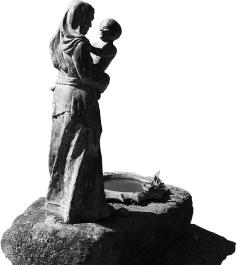A MONASTIC ADVENTURE IN THE 21ST CENTURY
Notre Dame Priory officially commenced its existence on 22 February 2017 with an augural Solemn High Mass celebrated in St Patrick’s Church Colebrook, Tasmania, in the presence of Archbishop Julian Porteous and numerous clergy and faithful from around Australia.
The founder, Dom Pius Mary Noonan, is a professed monk of Abbaye Saint Joseph de Clairval in Flavigny-sur-Ozerain, France, who had been invited many years earlier to conduct retreats in Australia. These retreats, organised every other year with another monk from Flavigny, gave Dom Pius the conviction that there was a growing expectation around Australia for a traditional style Benedictine monastery. In order to achieve this, the then Abbot of Flavigny, Dom Antoine Beauchef, allowed Fr Pius to leave Flavigny in order to set up a community in the archdiocese of Hobart.
Where did this rather exotic idea of founding a monastery in Australia come from? The couple that invited the monks were troubled by the direction of our culture and civilisation, and their vision was to revitalise their homeland through an “injection” of traditional, contemplative Benedictine monastic spirituality. Their inspiration came principally from an article entitled “Western Monasticism – How the West Will Be Won Again,” which was published in an Australian Catholic periodical, Oriens. After reading the article, this young couple came to understand the pivotal role of Benedictine monasticism in civilising the western world, and that this is what was needed to heal the critical illness of the West today. They then felt a strong call to do everything they could to bring a traditional Benedictine monastic foundation to Australia, to spearhead the rebuilding of Christian culture and civilisation in the Land Down Under.
During the first ten months of the foundation, Fr Pius, along with a small initial group of candidates, lived in an unused presbytery in a suburb of Hobart called Lindisfarne. The community quickly outgrew this house and moved out to Rhyndaston, which is a 10 minute drive from their present location in Colebrook. The community would spend twenty months in Rhyndaston, in somewhat spartan living conditions, but very much enjoying the countryside and space to develop their community life.
In August 2018, the community was able to purchase, thanks to a large loan provided in part by the Catholic Development Fund of Tasmania and in part by private lenders, a large farm in Colebrook, the former Hardwick House, situated on Jerusalem Creek. It would take a year for the old manor house on Colebrook Road to be renovated and made usable by the community. In August 2019, the move was made. Here too the living conditions were somewhat difficult for the first couple years, as the building permit and the actual building of rooms for the monks took some time to eventuate.
In December 2019, the community acquired the former church of St Leonard’s (near Launceston), a wooden edifice that was dismounted and transported to Jerusalem Estate. This building too would take a year to meet all the regulations and be used as a church. It was solemnly blessed and opened by Archbishop Porteous on 25 March 2021 under the patronage of the Immaculate Conception of the Blessed Virgin Mary.
In 2023, five years after the purchase of Jerusalem Estate, the monks were able to pay off the existing mortgage over the property thanks to donations and also thanks to the sale of a portion of the south end of the farm. The monks now employ a local farmer to manage the farm with its flocks of sheep. The monks have also planted a vineyard on one of the slopes visible from the road. It is hoped that within five years or so there will be some wine available for purchase locally. Cana Press has also begun publishing good Catholic books and other printed material such as greetings cards and holy cards. A substantial vegetable garden and fruit tree orchards are also underway.
Updated April 2024


